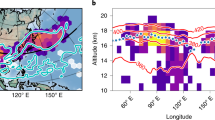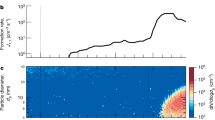Abstract
STRATOSPHERIC nitric acid condensation has recently been proposed1, 2 to take place in the cold winter polar vortex, priming it for chlorine-catalysed ozone destruction. This idea has been developed subsequently3–8. Condensation, thought to proceed via a heterogeneous heteromolecular mechanism involving stratospheric water vapour and pre-existing H2SO4/H2O aerosols, which serve as condensation nuclei, leads to solid nitric acid trihydrate (NAT; HNO3.3H2O) aerosols. It is expected1, 2, 8 that the condensation temperature, Tc(NAT), is significantly greater than that of water-ice, Tc(H2O-ice), given the stratospheric abundances of gaseous nitric acid and water and the thermodynamic properties of stratospheric aerosols8. Knowledge of Tc(NAT) is important because it determines the spatial and temporal extent of NAT aerosols and hence possibly of polar ozone destruction. Here we report in situ measurements of the detailed height distribution of gaseous nitric acid in the cold arctic vortex, using a balloon-borne technique9–16, which offers a much better altitude resolution (30 m) than previous satellite measurements17, 18. Our data set an upper limit to Tc(NAT) of 195 K at 23 km, and are consistent with model predictions based on the present gaseous nitric acid data, typical water vapour abundances and thermodynamic data8 of macroscopic NAT mixtures. However, our upper limit to Tc(NAT) is markedly lower than some of the early model estimates1, 2.
This is a preview of subscription content, access via your institution
Access options
Subscribe to this journal
Receive 51 print issues and online access
$199.00 per year
only $3.90 per issue
Buy this article
- Purchase on Springer Link
- Instant access to full article PDF
Prices may be subject to local taxes which are calculated during checkout
Similar content being viewed by others
References
Crutzen, P. & Arnold, F. Nature 324, 651–655 (1986).
Toon, O. B., Hamill, P., Turco, R. P. & Pinto Geophys. Res. Lett. 13, 1284 (1986).
McElroy, M. B., Salawitch, R. J. & Wofsy, S. C. Geophys. Res. Lett. 13, 1296–1299 (1986).
Poole, L. R. & McCormick, M. P. Geophys. Res. Lett. 15, 21–23 (1988).
Molina, M. J., Tso, T. L., Molina, L. T. & Wang, F. C. Y. Science 238, 1253–1257 (1987).
Tolbert, M. A., Rossi, M. J., Malhorta, R. & Golden, D. Science 238, 1258–1260 (1987).
Leu, M. T. Geophys. Res. Lett. 15, 17–20 (1988).
Hanson, D. & Mauersberger, K. Geophys. Res. Lett. 15, 855–858 (1988).
Arnold, F., Heitmann, H. & Oberfrank, K. Planet. Space Sci. 32, 1567–1576 (1984).
Arnold, F. & Hauck, G. Nature 315, 307–309 (1985).
Knop, G. & Arnold, F. Planet Space Sci. 33, 983–986 (1985).
Arnold, F., Knop, G. & Ziereis, H. Nature 321, 505–507 (1986).
Knop, G. & Arnold, F. Planet Space Sci. 35, 259–266 (1987).
Arnold, F. & Knop, G. Int. J. Mass Spectrom. Ion Proc. 81, 33–44 (1987).
Knop, G. & Arnold, F. Geophys. Res. Lett. 14, 1262–1265 (1987).
Arnold, F. et al. A. Rep. Max-Planck-lnstitut für Kernphysik (1988).
Gille, J. C. et al. J. geophys. Res. 89, 5179–5190 (1984).
Gille, J. C. & Russell III, J. M. J. geophys. Res. 89, 5125–5140 (1984).
Austin, J., Garcia, R. R., Russell, J. M., Solomon, S. & Tuck, A. F. J. Geophys. Res. 91, 5477–5485 (1986).
Jackman, C. H., Guthrie, P. D. & Kaye, J. A. J. geophys. Res. 92, 995–1008 (1987).
Girard, A., Gramont, L., Loisnard, N., Boiteux, S. & Fergant, G. Geophys. Res. Lett. 9, 135–138 (1982).
Girard, A. et al. J. geophys. Res. 88, 5377–5392 (1983).
Murcray, D. G., Barker, D. B., Brooks, J. N., Goldman, A. & Williams, W. J. Geophys. Res. Lett. 2, 223–225 (1975).
Poole, L. R., Osborn, M. T. & Hunt, W. H. Geophys. Res. Lett. 15, 867–870 (1988).
Atmospheric Ozone 1985, WMO Report No. 16, Vol. II, 474 (1985).
US Standard Atmosphere, 1966. U.S. Government Printing Office, Washington D.C. 20402.
Kiehl, J. T., Boville, B. A. & Priegleb, B. P. Nature 332, 501–504 (1988).
Author information
Authors and Affiliations
Rights and permissions
About this article
Cite this article
Arnold, F., Knop, G. Stratospheric nitric acid vapour measurements in the cold Arctic vortex: implications for nitric acid condensation. Nature 338, 746–749 (1989). https://doi.org/10.1038/338746a0
Received:
Accepted:
Issue Date:
DOI: https://doi.org/10.1038/338746a0
This article is cited by
-
Flow reactor and triple quadrupole mass spectrometer investigations of negative ion reactions involving nitric acid: Implications for atmospheric HNO3 detection by chemical ionization mass spectrometry
Journal of Atmospheric Chemistry (1991)
-
A diagnostic for denitrification in the winter polar stratospheres
Nature (1990)
-
Evidence for stratospheric nitric acid condensation from balloon and rocket measurements in the Arctic
Nature (1989)
-
Stratospheric clouds and ozone depletion in the Arctic during January 1989
Nature (1989)
Comments
By submitting a comment you agree to abide by our Terms and Community Guidelines. If you find something abusive or that does not comply with our terms or guidelines please flag it as inappropriate.



